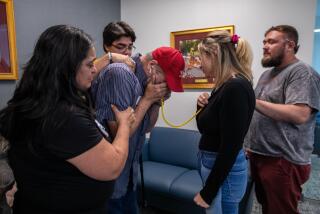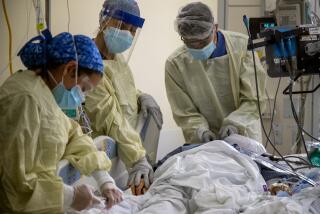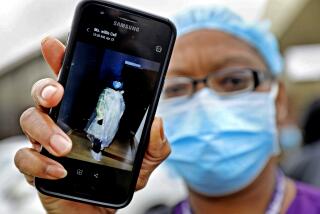Report Cites Blood Bank Deficiencies
After the terrorist attacks, blood banks discarded supplies at nearly five times the usual rate and gave such mixed messages about the need for blood that donations since have plummeted, an industry report says.
In the three months after Sept. 11, a national sample of 25 blood banks collected 191,000 more units of blood than average, according to the National Blood Data Resource Center. But at least 111,633--or 58%--of those units were discarded because they remained unused and were no longer fresh after 42 days.
For the record:
12:00 a.m. Feb. 2, 2002 FOR THE RECORD
Los Angeles Times Saturday February 2, 2002 Home Edition Main News Part A Page 2 A2 Desk 1 inches; 32 words Type of Material: Correction
Red Cross official--In some editions of Thursday’s paper, an article in Section A on blood bank deficiencies incorrectly spelled the first name of Allan Ross, vice president of technical operations at the American Red Cross.
Experts say the true amount of waste was far greater, because the sampled centers account for a third of U.S. blood collections. Also, the figures do not include blood discarded by hospitals.
The report, penned by a task force of blood centers, is the most thorough measure to date of blood industry shortcomings after the Sept. 11 attacks.
In addition to wasted blood, the report cites increased error rates in donor screening; “donor confusion and disenchantment”; and financial losses associated with collection.
Karen Shoos Lipton, chief executive of the American Assn. of Blood Banks, said the consequences could be severe.
“What we’re very concerned about is having [donors] look and say, ‘You had plenty of blood and you didn’t really need all the blood for the emergency,’ ” Lipton said.
Much of the industry’s concern has been directed at the American Red Cross, which supplies 45% of the nation’s blood and sought to stockpile blood collected after Sept. 11 for future needs.
For whatever reason, donors are feeling a lot less generous. Donations plummeted quickly in the wake of the disaster, and by December, blood banks were issuing urgent calls for donors to meet seasonal demands.
Twice as Many Errors Committed
In many centers, fewer than 8% of the September donors have responded to telephone calls, reminder cards and other pleas from blood centers for repeat donations, according to the report.
“For the most part, the blood community was unable to sustain the momentum created by the Sept. 11 tragedy,’ the report said.
The task force also reported that selected centers committed twice as many errors as usual--in some cases, failing to properly question donors about their health.
“Although most of these errors did not compromise the safety of the collected units, any increase in error rates is cause for concern,” said the report, to be presented today to a blood advisory committee to the Department of Health and Human Services.
Several Layers of Safety Mechanisms
Blood banks have several layers of safety mechanisms--including laboratory tests of all collected blood--to ensure tainted products are not used in transfusions.
The blood banks’ response to the Sept. 11 terrorist attacks exposed deep divisions in the industry, which has often split on strategic and safety issues, and resulted in mixed messages to donors. The Red Cross called on donors to continually give blood while other centers asked them to hold off.
Three days after the attacks, federal health officials convened a meeting of blood industry leaders, hoping to issue a joint statement encouraging donors to wait several weeks before giving. But because of opposition from the Red Cross, no statement was issued.
Red Cross officials say they were concerned at the time about the possibility of other terrorist events in the ensuing days and weeks. They also froze some blood for use in future shortages.
Criticism about the discarded units is 20-20 hindsight, said Alan Ross, the Red Cross’ vice president of technical operations.
“In times of uncertainty, I think being prepared is much better than not having any blood on the shelf,” Ross said. “We need to be prepared at all times in having adequate amounts of blood on the shelf.
“Right now [the federal government] is stockpiling Cipro and vaccines as part of its disaster preparedness,” he added. “We need to do the same thing with blood.”
Officials at America’s Blood Centers say they had to discard few units because their centers turned away excess donors early on. The group is a consortium of independent blood centers that gather 45% of the nation’s blood supply.
“We have such a great communication with all of our members,” said Lisa Marie Brody, the group’s director of government relations. “Perhaps that communication was not there with the Red Cross national office because they take care of a lot of things, including blood. Our members are trained and have expertise in assessing and determining medical need.”
The task force cited two lessons learned from the disaster response: Don’t collect more blood than can be used and ensure that all blood centers have adequate supplies on hand to respond to disasters at any time.
Hints to Achieve a Better Response
To better respond in an emergency, the group recommended better coordination between different industry players and common messages to donors.
Among the task force’s recommendations:
* The blood center located closest to the disaster should determine the medical need for blood and should not accept more blood than it can possibly use.
* The industry should develop messages to inform the media and the public that “most disasters do not generate a need for massive amounts of blood.”
* The industry should establish ways to transport blood if disasters create disruptions to air traffic or other modes of transportation, as occurred around Sept. 11.
While criticizing the blood industry’s reaction to the terrorist attacks, the task force also said blood centers, as a whole, must do more to collect blood every day to ensure that adequate supplies exist if a disaster occurs.
More to Read
Sign up for Essential California
The most important California stories and recommendations in your inbox every morning.
You may occasionally receive promotional content from the Los Angeles Times.










